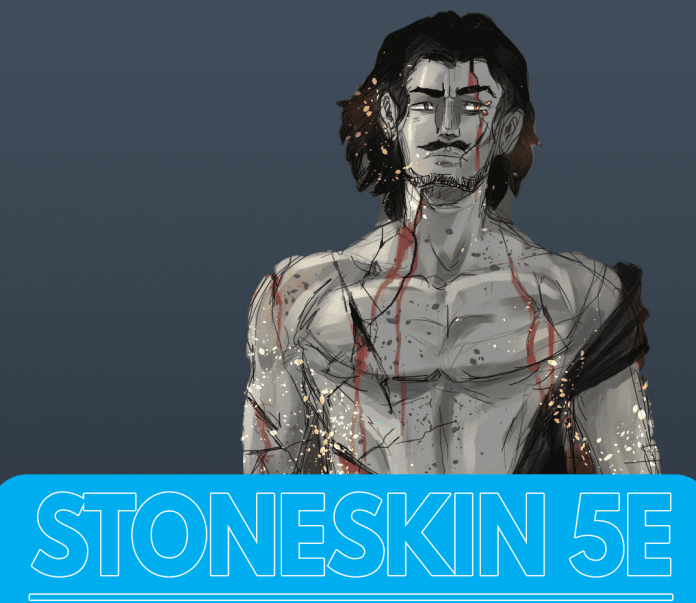Last Updated on January 31, 2023 by admin
When you cast this spell, you will turn the tissues of a willing animal into Stone. Until the spell closes, the objective has Resistance to nonmagical pummeling, puncturing, and slicing harm. A stone skin is a type of silver that has the power to transform its skin into Stone. It gives them more outstanding durability, but they are still vulnerable to more significant amounts of force. Stoneskin is an entirely passive effect with no somatic component needed to maintain its effects.
It is designed for 5th edition Dungeons & Dragons (D&D), although stone skin 5e may also be used with other tabletop role-playing games. Light weapons require two hands and deal 1d8 damage (with no Strength bonus; 1d6 if Small). If you roll a natural one on your attack roll with a light melee weapon, it breaks. See the weapon tables on pages 147-154 of the Player’s Handbook for other effects of magical weapons. A single word can’t be both a heavy and a light melee weapon.
Editions of stone skin are:
Table of Contents
3rd Edition
The 3rd edition version of stoneskin was a thicker skin without additional resistance to damage. Creatures who used both stone skin and resist energy in the 3rd Edition gained 2/3 as much protection from weapons compared to a character with either spell alone.
4th Edition
In 4th Edition, Stoneskin is an encounter power usable by many characters, including the Greater Stone Elemental, that lasts for ten minutes and gives creatures resistance to all but psychic damage when cast at that level. While in 3rd Edition, the spell required concentration. In the 4th Edition, it is available as an encounter power to specific classes. It works exactly like before but also costs 1d6 points of damage each time it takes effect.
5th Edition
The spell has been removed from the 5th edition rulebooks Cite Stoneskin 5e. In previous editions, it turned a willing creature’s skin into Stone until the end of its next turn. No 5th edition rules exist for the spell directly; however, the resist energy spell was again introduced in that Edition with a similar purpose and duration. A creature you touch will become as hard as a stone for the rest of its turn if you cast that spell on it. A nonmagical attack, such as piercing, slashing, or bludgeoning, will not affect a target until that time. In this spell version, you touch a willing creature to give it a one-minute damage bonus.
Different aspects of Stoneskin 5e
Length: 1 hour
1 minute 10 feet
Target: one willing creature
Components: V, S, M (a small piece of granite)
The target has resistance to nonmagical bludgeoning, piercing, and slashing damage.
You choose a 5-foot square unoccupied by you and mark it with a sigil. When a creature enters the area for the first time on a turn or starts there, it must make a Dexterity saving throw. On a failed save, the creature takes 2d6 of either radiant or necrotic type (your choice when you cast this spell) and is pushed 5 feet away from the center point of your sigil in your chosen direction. In addition, you can cause the spell to deal an extra 2d6 damage whenever you are hit with a melee attack (no action required). The target has resistance to nonmagical bludgeoning, piercing, and slashing damage.
BONUS:
The bonus equals your caster level (if a Cleric or Druid) or Charisma modifier (from another class), which only applies when the target makes a successful attack against an orc or goblin. This bonus manifests as stone skin-like skin on parts of the user’s body at random or placed by choices such as armor parts and weapon hafts, giving them the appearance of having rocks sticking out all over their body. When cast as a 5th-level spell, this acts like stone skin.
Target resistance duration:
You can choose up to ten creatures or piles of tiny objects that are all within range, and you can see each other when you cast this spell. A target’s AC becomes 10 + its Dexterity modifier for attacks made with non-reach weapons. The target has a disadvantage on attack rolls with any weapon it cannot use due to its restricted motions (e.g., hand-held or natural weapons) while the spell persists. The target has an advantage on Strength and Dexterity checks while the spell continues. The first time that each of up to ten creatures you can see who are within range of this spell makes an unarmed strike with a hand that isn’t holding a weapon, it deals 2d8 + its Strength modifier bludgeoning damage. This spell does not affect unarmed strikes made using a weapon held in the off-hand.

Dependence of spell’s level:
The spell’s level depends on what you chose in step 4 of casting more incredible restoration. If you decide to heal the target’s hit point maximum, it is a 5th-level spell (for targets with less than half of their max HP; otherwise, 6th). If you choose to remove an effect acting upon the target (such as poison or paralysis), then it is a 3rd-level spell. If your choice was “curse” or “exhaustion,” it is 2nd-level.
Effect of Stone’s concentration:
When casting stones on a target, the caster’s concentration on the spell ends if the creature moves further than 30ft from them, the stone skin remains active on the target until it or they move out of range of the caster. Requirement of the somatic component while casting spells As stated in the official stone skin 5e sources, no somatic components are required to provide a passive effect. It would be safe to assume that Stone skin is an entirely passive effect with no somatic component needed to maintain its effects. It does not have any listed saving throws, damage rolls, or other associated actions beyond defense. Nonetheless, this could easily change in future products, and errata should be considered unofficial until otherwise addressed.
Read more: The 7 Best Digital Games to Try on Your Phone.
Requirement of stoneskin 5e concentration:
Concentration is still required, but the spell now lasts 10 minutes. There is no need to pay attention to the spell, but it only lasts one minute. When you have 1 minute, you will almost always cast it on your first turn in combat. This spell is best suited to more defensive casters, like the druid, but it’s situational. As per all concentration spells, if you are attacked or forced to move half your movement speed or further by an outside source, then concentration breaks. When concentration breaks, any remaining magic duration still ticks down until it expires with no effect. Usually, when a spell with a duration runs out of time, the magic dissipates harmlessly without incident unless stated otherwise. Still, it does not automatically dispel because stone skin has no other effects besides the damage resistance that grants immunity to magical weapons. Because of this, any remaining duration not used up before expiring will recover the damage resistance presented by stone skin, which makes this spell so situational to use in-game.
The casting of stoneskin 5e:
When you cast this spell using a spell slot of 3rd level or higher, the damage of both effects increases by 1d6 for each slot above 2nd. You choose either radiant or necrotic type when you cast this spell; the type you choose is the same as that used by your Sigil ability.
Can A Weapon Be Used While Invisible In 5e?
The pyrotechnic device does not shatter invisibility because it is neither a spellcaster nor an attacker (no attack dice). This appears true across all magical objects that do not require a spell or an assault. Remember that other spells can cause invisibility to expire based on their accomplishments. You cannot direct a magic projectile at “any orcs in the room” or remove “any invisibility spells in the room” using magic. You must be able to choose a specific target and direct your spell just at that target.
Summary:
Stoneskin 5e does not require somatic components. Still, targets must stand on solid ground or stone flooring for the duration to begin, so only defensive casters should use this spell. No 5th edition rules exist for the spell directly; however, the resist energy spell was again introduced in that Edition with a similar purpose and duration. This article will help you create your custom magic items similar to those listed in D&D 3rd Edition and D&D 4th Edition, but with a 5th edition twist. Unique Benefits If you decide that the item was made by a legendary artificer, craftsman, or smith, you can give it an additional minor power for free. The weapon has an additional +1 enhancement bonus and is one category lighter (to a minimum of light).















